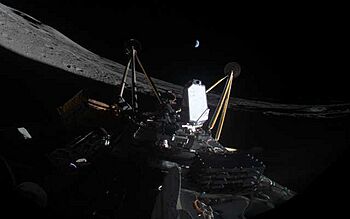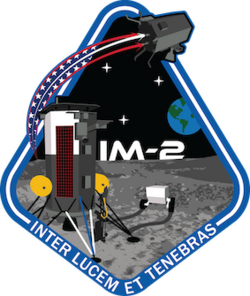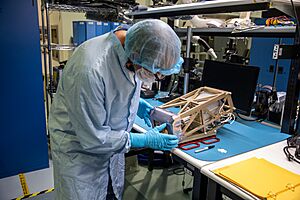IM-2 facts for kids

Athena rests sideways after landing
|
|
| Mission type | Lunar landing |
|---|---|
| Operator | Intuitive Machines |
| Mission duration | 8 days, 5 hours, 59 minutes |
| Spacecraft properties | |
| Spacecraft | Athena |
| Spacecraft type | Nova-C |
| Manufacturer | Intuitive Machines |
| Launch mass | 2,120 kg (4,670 lb) |
| Start of mission | |
| Launch date | 27 February 2025, 00:16:30 UTC |
| Rocket | Falcon 9 Block 5 B1083-9 |
| Launch site | Kennedy, LC-39A |
| Contractor | SpaceX |
| End of mission | |
| Last contact | 7 March 2025, 06:15 UTC |
| Lunar lander | |
| Landing date | 6 March 2025, 17:28:50 UTC |
| Landing site | Mons Mouton (84°47′26″S 29°11′45″E / 84.7906°S 29.1957°E) |
 IM-2 mission insignia Motto: INTER LUCEM ET TENEBRAS (Between Light and Darkness) |
|
IM-2 was a space mission to the Moon. It was carried out by a company called Intuitive Machines. This mission was part of NASA's Commercial Lunar Payload Services (CLPS) program. The goal of CLPS is for NASA to work with private companies to send experiments to the Moon.
The IM-2 mission launched on February 27, 2025. It used a special lunar lander called Athena. This lander was a Nova-C spacecraft. Athena reached the Moon's surface on March 6, 2025. During the landing, contact with the lander was lost for a short time. When it came back, engineers realized Athena had landed sideways. This meant its solar panels could not get enough sunlight. Because of this, the mission ended on March 7, 2025, when Athena ran out of power.
Athena carried special tools to look for lunar water ice. One main tool was called PRIME-1. It had a drill and a device to measure gases. The mission also had a small drone. This drone was designed to explore dark, cold areas on the Moon. It would look for signs of solid water ice. Finding water on the Moon is very important for future space missions.
Contents
What Was the Mission About?
NASA created the CLPS program to team up with private companies. This helps them send scientific tools and experiments to the Moon. The IM-2 mission was Intuitive Machines' second contract with NASA for this program.
Before IM-2, three other CLPS missions had launched:
- Astrobotic Technology's Peregrine mission in January 2024 did not reach the Moon. It had problems shortly after launch.
- Intuitive Machines' own IM-1 mission in February 2024 successfully landed its Odysseus spacecraft on the Moon. However, the landing was a bit rough, and the lander tipped over. Still, the company called it a success.
- Firefly Aerospace's Blue Ghost Mission 1 landed smoothly on March 2, 2025.
The IM-2 mission, which launched on February 27, 2025, was the fourth CLPS launch. It was on its way to the Moon when the Blue Ghost lander arrived.
What Did Athena Carry?
The Nova-C Lander
Intuitive Machines was chosen in October 2020 to land a second Nova-C lander near the Moon's south pole. NASA picked a spot near Shackleton crater. Scientists believe there might be ice hidden under the surface there. After the first IM-1 mission had a rough landing, engineers made changes to Athena. They improved the landing system to help it land more precisely.
Athena also carried a small device called MiniPIX TPX3 SPACE. This device was made by a Czech company. Its job was to check the radiation levels on the Moon. This helps scientists learn how to protect astronauts and equipment from harmful space radiation. This was the first time a Czech-made tool was planned to land on the Moon.
The Micro-Nova Hopper
| Mission type | Lunar hopper |
|---|---|
| Spacecraft properties | |
| Manufacturer | Intuitive Machines |
| Payload mass | 1 kg |
| Start of mission | |
| Rocket | Falcon 9 Block 5 |
| Launch site | Kennedy, LC-39A |
| Moon rover | |
| Landing site | Shackleton connecting ridge |
During the mission, Athena was supposed to release a smaller vehicle. This was the μNova (Micro-Nova) Hopper, also called "Grace." It was designed to separate from Athena after landing. The Micro-Nova could then hop around the Moon's surface. It used small rockets to jump short distances. This would let it explore hard-to-reach places, like deep craters.
The hopper's main goal was to find lunar ice. Water ice is very important because it could be used for future human missions to the Moon. It could be turned into rocket propellant or used to support a permanent lunar habitat. The Micro-Nova was also planned to take the first pictures from inside craters at the Moon's south pole. It could carry a 1-kilogram payload and travel more than 25 kilometers. It might even have flown into a lava tube to send back images.
The MAPP Rover
| Mission type | Lunar rover |
|---|---|
| Spacecraft properties | |
| Manufacturer | Lunar Outpost |
| Landing mass | 5–10 kg |
| Payload mass | 15 kg |
| Start of mission | |
| Launch date | 27 February 2025 |
| Rocket | Falcon 9 Block 5 |
| Launch site | Kennedy, LC-39A |
| Moon rover | |
| Landing site | Mons Mouton |
| Mission type | Lunar rover |
|---|---|
| Spacecraft properties | |
| Manufacturer | MIT |
| Dimensions | The size of a matchbox |
| Start of mission | |
| Launch date | 27 February 2025 |
| Launch site | Kennedy, LC-39A |
| Moon rover | |
| Landing site | Mons Mouton |
Another important payload was the Mobile Autonomous Prospecting Platform (MAPP) rover. This was the first lunar rover from the company Lunar Outpost. MAPP was designed to collect lunar samples for NASA. It was a very small contract, worth only $1. This showed a new way for private companies to get involved in space resource missions.
MAPP weighed about 5–10 kilograms and could carry up to 15 kilograms of other equipment. It could move at a top speed of 10 centimeters per second. Over several days, the rover was meant to map the Moon's surface by itself. It would take 3D pictures and thermal data. It would also examine samples of lunar regolith (Moon soil) using a special bin on its wheels. MAPP would send its photos and data back to the Athena lander using radio. It also carried a tiny rover called AstroAnt, made by MIT. AstroAnt was the size of a matchbox and would measure temperatures as it drove on MAPP's roof.
The mission also included a test of 4G cellular internet on the Moon. This was a partnership with Nokia Bell Labs and NASA. Nokia's equipment would connect the Athena lander with the MAPP rover and the Micro-Nova Hopper. This 4G/LTE network would offer faster communication than older systems. Nokia hopes that future Moon bases will use shared internet systems.
The Yaoki Rover
IM-2 also carried a small Moon rover named Yaoki. It was made by a Japanese company called Dymon and weighed 498 grams.
PRIME-1
The main scientific tool was the Polar Resources Ice Mining Experiment-1 (PRIME-1). It was designed to look for water ice in a permanently shadowed area near Shackleton Crater. PRIME-1 had two main parts:
- TRIDENT: This was a drill that could dig up to three feet deep into the Moon's surface. It would bring up samples of lunar soil.
- MSolo: This was a special device that could measure the amount of water and other chemicals in the soil samples.
A similar version of TRIDENT and MSolo was planned for NASA's VIPER rover, which was later canceled. PRIME-1 weighed 40 kilograms. It was meant to help scientists learn about using resources found directly on the Moon.
Mission Timeline
Before Launch
In May 2024, Intuitive Machines announced that Athena was almost ready. They also said they were improving the lander's software and hardware. This included making the landing legs better for more precise landings. By September 2024, the company expected to launch in January 2025. Another spacecraft, the Lunar Trailblazer orbiter, was also planned to launch on the same rocket. In November 2024, Intuitive Machines announced the launch was aimed for February 2025.
The original landing spot for IM-2 was near Shackleton Crater. However, before launch, the target was changed to Mons Mouton. This is a high plateau near the Moon's south pole. It was also the planned landing site for the canceled VIPER rover.
Launch
IM-2 launched on February 27, 2025, at 00:16 UTC. It lifted off on a SpaceX Falcon 9 rocket. About 45 minutes after launch, Athena separated from the rocket and made contact with controllers on Earth. The next morning, it was confirmed that the mission was on track to enter orbit around the Moon on March 3. The landing attempt was set for March 6.
Landing
On March 6, three minutes before landing, Athena began its final descent. As it got closer, a cloud of lunar dust blocked its navigation systems. This made it hard for the lander to get accurate readings and also messed with its radio signals. After a short period of no communication, mission controllers confirmed that Athena had landed. It was generating some power. However, one of its two radio antennas was not working, and it was not making as much power as expected.
At a press conference, the CEO of Intuitive Machines said that Athena had not landed upright. Its solar panels were not facing the Sun correctly. Even so, the lander started doing some scientific work, but with limited power. On March 7, pictures sent back showed that Athena had landed sideways inside a shadowed crater. The temperature there was extremely cold. The solar panels were only making about 100 watts of power. This was not enough to run both the heaters and the main antenna. So, mission operators decided to collect as much data as possible for 13 hours. They could not run the heaters to keep the mission going longer. During this time, Athena sent back images and data from the Moon's south pole. The TRIDENT drill extended but did not operate. Some private customers, like Nokia, got useful data from their equipment. However, the rovers and Micro-Nova could not be deployed.
On March 13, Intuitive Machines explained what happened. Just like on the IM-1 mission, Athena's altimeter (a device that measures height) failed during landing. This meant the computer didn't know its exact altitude. As a result, the spacecraft hit a flat area, tipped over, and slid across the Moon's surface. It rolled once or twice before stopping inside a crater. The company's CEO compared it to a baseball player sliding into a base. The impact also kicked up dust, which covered the solar panels and made them work even worse.
After the Mission
On March 7, 2025, the Lunar Reconnaissance Orbiter (LRO) took a picture of the Athena spacecraft. It had landed inside a 20-meter-wide crater. The orbiter took another picture on March 10 from a different angle.
On March 7, 2025, Intuitive Machines announced that the mission was over. Athena had landed on its side in the Mons Mouton area near the Moon's south pole. NASA confirmed that the lander stopped working less than 13 hours after it landed.
More to Explore


